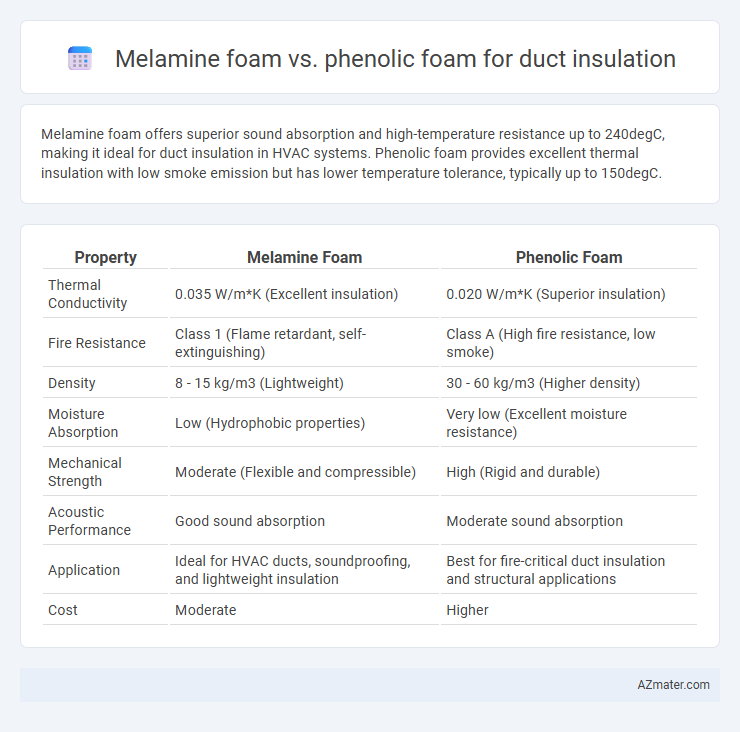Melamine foam offers superior sound absorption and high-temperature resistance up to 240degC, making it ideal for duct insulation in HVAC systems. Phenolic foam provides excellent thermal insulation with low smoke emission but has lower temperature tolerance, typically up to 150degC.
Table of Comparison
| Property | Melamine Foam | Phenolic Foam |
|---|---|---|
| Thermal Conductivity | 0.035 W/m*K (Excellent insulation) | 0.020 W/m*K (Superior insulation) |
| Fire Resistance | Class 1 (Flame retardant, self-extinguishing) | Class A (High fire resistance, low smoke) |
| Density | 8 - 15 kg/m3 (Lightweight) | 30 - 60 kg/m3 (Higher density) |
| Moisture Absorption | Low (Hydrophobic properties) | Very low (Excellent moisture resistance) |
| Mechanical Strength | Moderate (Flexible and compressible) | High (Rigid and durable) |
| Acoustic Performance | Good sound absorption | Moderate sound absorption |
| Application | Ideal for HVAC ducts, soundproofing, and lightweight insulation | Best for fire-critical duct insulation and structural applications |
| Cost | Moderate | Higher |
Introduction to Duct Insulation Materials
Melamine foam offers excellent sound absorption and thermal insulation with a lightweight, open-cell structure ideal for HVAC duct applications. Phenolic foam provides superior fire resistance and thermal performance due to its closed-cell composition, making it suitable for high-temperature duct insulation. Both materials enhance energy efficiency and indoor air quality but differ in cost, durability, and specific thermal conductivity values.
Overview of Melamine Foam
Melamine foam is a lightweight, open-cell material known for its excellent thermal insulation and sound absorption properties, making it ideal for duct insulation applications. It offers high fire resistance with a low smoke emission rate, complying with stringent building codes and safety standards. Compared to phenolic foam, melamine foam provides superior noise reduction and flexibility, enhancing ductwork efficiency and comfort.
Overview of Phenolic Foam
Phenolic foam is a rigid, closed-cell insulation material known for its excellent thermal performance, low smoke emission, and high fire resistance, making it ideal for duct insulation in commercial and industrial applications. Its superior dimensional stability and moisture resistance contribute to long-lasting durability and energy efficiency in HVAC systems. Compared to melamine foam, phenolic foam offers higher compressive strength and better resistance to elevated temperatures, enhancing system reliability.
Thermal Performance Comparison
Melamine foam offers superior thermal insulation properties with a low thermal conductivity typically around 0.035 W/m*K, making it highly effective for duct insulation by minimizing heat transfer and enhancing energy efficiency. Phenolic foam also provides excellent thermal resistance with thermal conductivity values close to 0.020-0.025 W/m*K but tends to perform better in fire resistance and dimensional stability under high-temperature conditions. Selecting between melamine and phenolic foam for duct insulation depends largely on the required balance between thermal conductivity and fire safety standards in HVAC applications.
Fire Resistance and Safety Ratings
Phenolic foam exhibits superior fire resistance for duct insulation due to its low smoke emission and high flame retardancy, meeting stringent safety ratings such as ASTM E84 Class A and NFPA 286 standards. Melamine foam also offers excellent fire safety properties, characterized by self-extinguishing behavior and low toxicity, but typically does not achieve the same flame spread index as phenolic foam. Selection between these materials depends on balancing fire safety requirements with thermal insulation performance and regulatory compliance in HVAC applications.
Acoustic Insulation Properties
Melamine foam offers superior acoustic absorption due to its open-cell structure, effectively reducing airborne noise in HVAC duct systems. Phenolic foam, while providing good thermal insulation, exhibits lower sound absorption because of its closed-cell composition, making it less effective for noise control applications. Choosing melamine foam for duct insulation optimizes acoustic comfort by attenuating sound transmission in ventilation systems.
Moisture and Chemical Resistance
Melamine foam exhibits superior moisture resistance due to its closed-cell structure, preventing water absorption and maintaining insulation performance in humid environments. Phenolic foam offers excellent chemical resistance, making it ideal for duct insulation exposed to corrosive agents and solvents. Choosing between melamine and phenolic foam depends on the specific environmental conditions, with melamine preferred for moisture control and phenolic for chemical exposure.
Installation and Handling Differences
Melamine foam offers superior flexibility and lightweight properties, making it easier to cut, shape, and install in complex duct configurations compared to the rigid structure of phenolic foam. Phenolic foam is denser and more brittle, requiring careful handling to avoid cracking during installation, while melamine foam's resilience reduces the risk of damage and speeds up the process. The inherent fire-resistant nature of both materials suits duct insulation, but melamine foam's ease of manipulation often results in lower labor costs and reduced installation time.
Cost Analysis and Long-Term Value
Phenolic foam generally offers higher thermal resistance and superior fire retardancy compared to melamine foam, but it comes at a higher initial cost, making it an expensive choice for duct insulation. Melamine foam, while less costly upfront, provides excellent acoustic properties and adequate thermal insulation, delivering better short-term savings for budget-conscious projects. Long-term value favors phenolic foam due to its durability, moisture resistance, and lower maintenance costs, which contribute to energy savings and extended service life in HVAC systems.
Environmental Impact and Sustainability
Melamine foam offers superior fire resistance and sound absorption with a lower environmental footprint due to its non-toxic composition and recyclability, making it a more sustainable choice for duct insulation. Phenolic foam, while providing high thermal insulation and fire retardancy, involves more energy-intensive manufacturing processes and contains formaldehyde-based resins, which raise environmental and health concerns. Choosing melamine foam supports greener building practices by reducing harmful emissions and enhancing indoor air quality.

Infographic: Melamine foam vs Phenolic foam for Duct insulation
 azmater.com
azmater.com